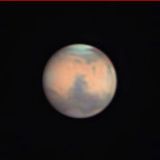
Explore the starry skies of April! There will be a number of intriguing celestial sights to enjoy during April with the help of a binocular or telescope. Here are a few of our favorites:
- Mars at Opposition - Earth will be positioned directly between the Sun and Mars on April 8th, presenting a great opportunity for backyard astronomers to observe the Red Planet with binoculars and telescopes. Use Orion's Mars Observation Filter Set to optimize your views of our neighboring planet. For more information on how to make the most of your Mars observations, read our Complete Guide to Viewing Mars in 2014 in the Orion Community section.
- Total Lunar Eclipse - The first total lunar eclipse in 2.5 years will occur in the very late hours of April 14th into the early morning hours of April 15th, 2014. The Moon will become eclipsed as it passes through the southern portion of Earth's dark shadow, which will make the northern half of the Moon's disk appear much darker than its southern half. With mid-eclipse occurring at about 12:45am PDT (3:45 EDT), and totality expected to last 78 minutes, you'll want to plan ahead to stay up late for this this must-see event which will be visible across North America and western South America.
- Saturn and the Moon - Use your favorite pair of 50mm or larger binoculars or a wide-field telescope to catch a nice view of the pairing of ringed planet Saturn and the Moon on the night of April 17th. Saturn will be positioned within just 23' of the Moon, making for an interesting celestial sight.
- Challenging Meteor - On April 23rd, the April Lyrids Meteor Shower is expected to peak, but unfortunately this popular perennial event will share the sky with the waning Moon, which will reach Last Quarter phase on April 22nd. The glare of the relatively bright Moon will hamper some meteor observations, but it will still be worthwhile to sit back in a comfy chair and try to sight meteors as they appear to radiate from the constellation Lyra in the northeastern sky.
- Binocular Bounty - Use 50mm or larger binoculars in April to explore our personal favorite constellation - Orion! The entire constellation is a treasure trove of celestial sights, but we especially enjoy observing M42, the Orion Nebula, with big astronomy binoculars. For even better observations of this cloudy nebula, use a 6" telescope like the popular Orion AstroView 6 EQ Reflector with a wide-angle, low-power eyepiece to obtain a nicely framed view of this stellar nursery where stars are formed.
- Last Call for Giant Jupiter - By mid-April, Jupiter will be approaching the horizon around 9-10pm, but the gas giant will still be high enough in the sky after sunset for some satisfying views. Bigger refractor and reflector telescopes and moderate to high power eyepieces will deliver the most rewarding views of Jupiter before it leaves the night sky for the season. Use an affordable Orion Jupiter Observation Filter to reveal cloud surface details and improve your view of the biggest planet in our solar system.
- Spring Brings Galaxy Season! - April skies provide stargazers with ample opportunities to observe far-off galaxies. With the Virgo Galaxy Cluster and bright galaxies in the Big Dipper and Coma Berenices well-positioned in the sky, April evenings are truly a gift for galaxy hounds. Check out a few of our favorite galaxies: M101, M51, and M106 near the Big Dipper asterism; M86, M87, M84 and M104 in the Virgo Galaxy Cluster; and don't miss NGC 4565, M64, M99, and M100 in the constellation Coma Berenices. While a humble 80mm telescope will show most of the galaxies we mention, a big reflector like our SkyQuest XT10 Classic Dobsonian will provide jaw-dropping views of these distant galaxies!
- April's Deep Sky Challenge: Leo Galaxy Cluster - You'll want a big reflector telescope and dark, clear skies to go after this month's challenge object; the compact galaxy cluster Hickson 44, also named the Leo Quartet, or Galaxy Cluster NGC 3190, after its brightest member. This grouping of distant galaxies is located less than halfway between the stars Adhafera (Zeta Leonis) and Algieba (Gamma Leonis) along the sickle asterism of constellation Leo. This grouping of faint galaxies is quite challenging to detect in telescopes, so we recommend using a large Dobsonian reflector to find out how many galaxies you can see. Learn more about April's Deep Sky Challenge in this info-packed Community section article.
All objects described above can easily be seen with the suggested equipment from a dark sky site, a viewing location some distance away from city lights where light pollution and when bright moonlight does not overpower the stars. All objects have been verified by actual observations by Orion Telescopes & Binoculars Staff at Fremont Peak State Park, and/or Deep Sky Ranch, 60 miles and 90 miles respectively from San Jose International Airport, San Jose, CA.




















